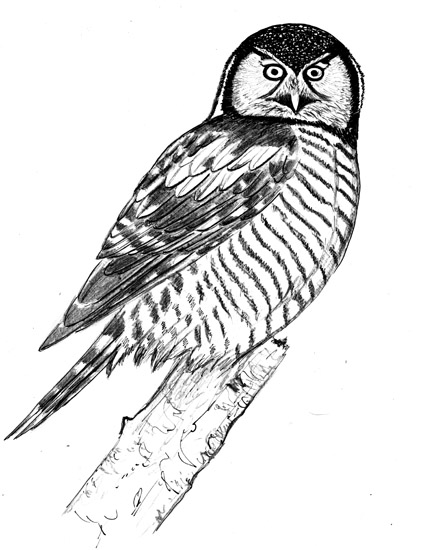
Dear Bird Folks,
On a recent family vacation in Vermont, we came upon a large group of birders standing on the side of Rt. 100. My son, who likes to photograph birds, yelled that we should pull over. He figured the birders must have found something good. When I asked what everyone was looking at, I was told they were watching a “hawk owl.” I’m not familiar with this bird. Is it rare? Should I have stopped?
– Eric, Harwich, MA
Good for you, Eric,
I’m glad you pulled over so your son could photograph the bird. My old man would never stop the car when our family was on a trip. (Although he threatened to, “Turn this car around right now!” a few times.) My father wouldn’t have stopped the car even if he saw the Pope hitchhiking, let alone to see what birders were looking at. So, yes, you totally should have stopped and I hope your son got a good photo. I also hope you didn’t let your kids get too close to any of the birders. There are certain things in life children should not be exposed to.
The winter of 2013/2014 could go down as the best ever to see rare owls. A few weeks ago everyone got excited when a Snowy Owl arrived on Cape Cod, now it seems every single beach has at least one, with some beaches having two or three. (If you haven’t gotten a look at a Snowy Owl yet, you only have your lazy self to blame.) However, Northern Hawk Owls are a different story. They are extremely rare visitors from Canada. Hawk owls themselves aren’t rare, but their visits to New England are. How rare are these visits? In Massachusetts, for example, we’ve actually seen more wild, living (not plastic) flamingos than hawk owls. Like the Snowy Owls, hawk owl visits are typically related to food supplies. When summer food is abundant, the owls tend to crank out more kids. But these young owls may eventually deplete the available prey, which causes them to move south searching for more food. When their travels bring them to the U.S., they are instantly greeted like rock stars, attracting hordes of birders, photographers and at least one family from Cape Cod.
Hawk owls are interesting creatures. The bird’s name, “hawk owl,” is rather odd in itself. Is it a hawk or an owl? It conjures up two separate images, like catbird, cowbird or titmouse. The bird is actually an owl, but its body and feeding behavior remind many observers of a Cooper’s Hawk. In addition, unlike typical owls, hawk owls like to hunt during the day, just like hawks do. I can totally understand why the owl would prefer to hunt during the day; it’s easier to spot the prey. Hunting in the dark has to be more challenging. Plus, when owls capture food in the dark, they have no idea what they are eating. It’s like eating popcorn in the movie theater. You assume you’re eating popcorn, but who knows what greasy, lumpy things are actually in that box? To help them locate prey, hawk owls have outstanding vision and excellent hearing. A hawk owl can easily spot prey a half-mile away. That’s right, a half-mile! I keep binoculars by the window so I can see the birds on the feeders in my backyard, yet these owls can see a vole in another part of town. When winter comes and snow covers the ground, you might think it would be impossible for the birds to find food, but hawk owls’ sensitive ears allow them to hear, locate and capture voles and mice hiding a foot beneath the snow. When the snow becomes too deep, the owls stop hunting voles and start hunting birds, including grouse and ptarmigan. But I don’t want to talk about that.
Hawk owls are one of our least understood and studied birds because they are normally found in distant, isolated pockets in the vast forests of northern Canada. Because they have so little contact with humans, they tend to be more tolerant of us. Photographers love birds like this because they allow a close approach. However, hawk owls can easily be overlooked. From a distance they look like small hawks, with jumbo-sized heads and long tails. They have bright yellow eyes and brown and gray barred plumage. In addition to Canada and Alaska, hawk owls can be found in other parts of the world, including northern Russia and Scandinavia, where the birds are mostly blonde with blue eyes. The voice of the Northern Hawk Owl is not anything like the stereotypical “hoo” we often associate with other owls. The hawk owl sound has been described by some observers as resembling the sound of a parakeet, which has to be awkward for a mighty owl. Some people feel that their embarrassing voice is the main reason hawk owls choose to live in such isolated places. Yeah, I can totally see that.
I’m glad you stopped so your family could see the hawk owl, Eric. I would love to see the photos your son took. Speaking of owl photos: I continue to encourage folks to visit area beaches in hopes of seeing a Snowy Owl, but I really would like to emphasize that everyone needs to keep their distance. Most of these visiting birds are young, with poor hunting skills. I know that at least four of the Cape’s Snowy Owls have died, probably of starvation. So please, watch these birds from a distance, without making them fly or stressing them out. However, if you see the Pope hitchhiking, you can get as close as you want. This new guy seems pretty cool and I don’t think he minds having his photo taken. Just don’t send me any of the photos. My mother has already sent me plenty.